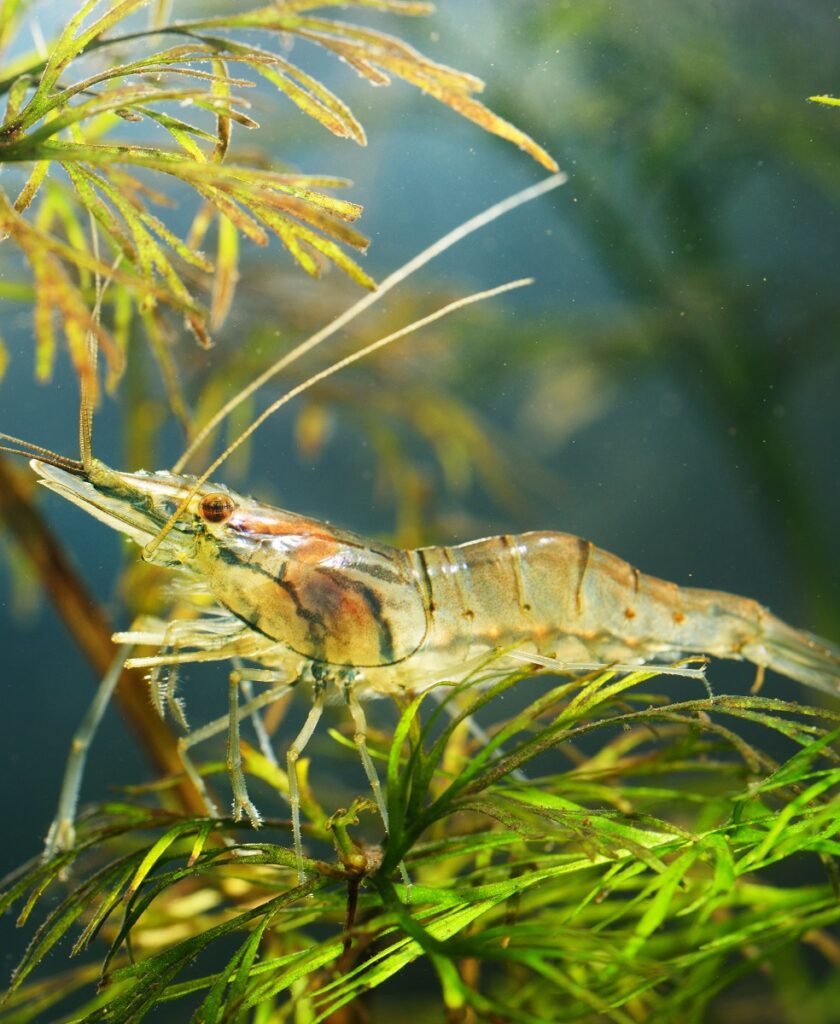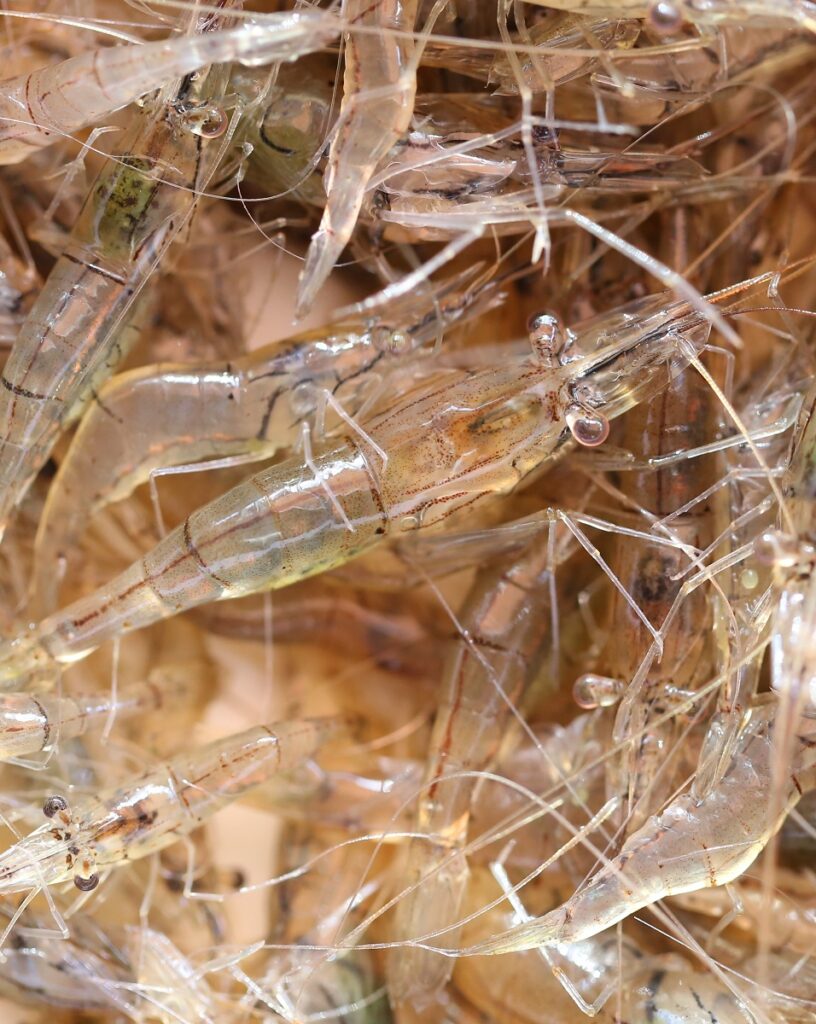Whisker Shrimp Care & Info | Macrobrachium lanchesteri
Dwarf shrimp? It's been done. Amano shrimp? Standard. Ghost shrimp? Yawn. If you're an experienced shrimp keeper ready for something different (or if you just want to start your shrimp hobby with a more unusual species), keep reading. The whisker shrimp is often written off as too aggressive, but it's actually easy to keep and can make a fascinating aquatic pet.
Keep reading for everything you need to know about whisker shrimp (Macrobrachium lanchesteri) care and how to keep this feisty shrimp in your home aquarium!
| Scientific name | Macrobrachium lanchesteri |
| Common names | Whisker shrimp, Asian glass shrimp, riceland prawn |
| Difficulty level | Easy |
| Origin | Southeast Asia |
Table of Contents
Whisker shrimp natural habitat & appearance
Natural habitat
This species' other common names, "Asian glass shrimp" and "riceland prawn", give a pretty good indication of where it's from. Indeed: Machrobrachium lanchesteri is naturally found in Southeast Asia, specifically in Malaysia, Singapore, Thailand, Brunei and Laos.
The whisker shrimp is widespread in its natural range. It's very not fussy about habitat, although it does prefer still, slow-moving and shallow waters. The species can be found everywhere from streams and rivers to man-made waters like rice paddies, ditches, ponds and reservoirs.
The IUCN lists Macrobrachium lanchesteri as a species of Least Concern, noting a wide distribution and few threats.
Did you know? The whisker shrimp is also an introduced species in some areas. One example is Lake Lindu in Sulawesi, Indonesia, where it unfortunately poses a threat to local species such as Sulawesi shrimp. Many of these are already critically endangered.
Appearance
As far as freshwater aquarium shrimp go, whisker shrimp are one of the larger species. Although they usually don't surpass 1.5" in length, some specimens do grow to up to 2.5" (claws excluded).
This species can be recognized by its transparent body, back hump, and the typical black pattern just behind its head.
Here's how you tell it apart from similar translucent aquarium shrimp:
- Whisker shrimp vs ghost shrimp: the latter has a more pronounced back hump, much shorter arms, and a more dotted pattern.
- Whisker shrimp vs Amano shrimp: the latter lacks the back hump, has much shorter arms, and sports a pattern of dots and dashes along its side.
As for the difference between male and female whisker shrimp, it's difficult to tell. The males tend to be a bit smaller than the females, but the only way to really be sure is if you find a female that's carrying eggs.
Tip: The whisker shrimp (Macrobrachium lanchesteri) shares a common name, and is very similar to, the Indian whisker shrimp (Macrobrachium lamarrei). The good news is that their care requirements are almost identical as well, so there's no need to worry if you're not sure which shrimp you've got on your hands.
Setting up a whisker shrimp aquarium
Requirements
Whisker shrimp are considered easy to keep and beginner-proof. They don't need much to thrive, although it is recommended to go for an aquarium of at least 10 gallons due to their adult size and activity level.
These shrimp don't care much about aquarium décor, although it does appreciate some hiding places. After all, they are nocturnal, so they will like to spend at least part of the day tucked into a cave. Hides are also important while shrimp molt. Shrimp flats should work well, although you can also include rocks, driftwood, and leaf litter.
You can also opt to grow live plants in your aquarium, as whisker shrimp aren't known for eating or destroying them. Plants offer a nice place for your shrimp to forage and help keep the water quality stable.
Lastly, this species is known to jump when it panics. It's also capable of climbing out of the aquarium. A tank with a lid is preferable if you don't want to find any dried shrimp on the living room floor!
Water parameters
Although your tank should still be fully cycled and the water quality kept up to par, whisker shrimp are a bit less sensitive to ammonia, nitrites and nitrates than many other shrimp species. They do appreciate a heated aquarium, as the temperatures in their natural range tend to be pretty toasty.
To keep your whisker shrimp healthy, perform regular water changes. With the right care, yours can live up to 5 years!
pH: 6.5-8
Temperature: 75-85 °F
GH: 2-14
Total Dissolved Solids: 100-300
Tankmates
So if they're cool to look at and easy to keep, why doesn't everyone have whisker shrimp in their aquarium? Well, there's one little issue: this species is FEISTY and doesn't make for a very good neighbor for most fish and other invertebrates.
For starters, Macrobracium shrimp don't tend to play nice with their own species. If you'd like to keep multiple and can find confirmed females (carrying eggs), it may be a good idea to mostly avoid the more territorial males. Keep no more than 2-3 shrimp per ten gallons of water volume.
Additionally, these shrimp are opportunistic omnivores that will snatch prey if they get the chance. This isn't much of an issue when they're still small, but a 2" adult whisker shrimp can easily catch something like a sleeping guppy with those long claws!
Avoid slow (Betta), long-finned (guppy), small (neon tetras), and bottom-dwelling (dwarf Corydoras) species. Small and peaceful shrimp, like Neocaridinas or even Amano shrimp, aren't a good idea either. The same goes for small snails, which make an easy meal for a hungry Macrobrachium.
So what does that leave us with in terms of tankmates? You can't go for large fish either, as those will eat the shrimp themselves. Most aquarists end up choosing a single-species setup. You could also try something like larger, quick tetras or barbs. Bigger Cory cat varieties could also work.
Whisker shrimp diet
As mentioned, whisker shrimp are omnivores that will eat pretty much anything they can find. You won't have any trouble keeping yours well-fed as long as you offer it a balanced diet with plenty of protein, some plant-based foods, and a source of calcium.
Regular shrimp foods will work well. Other good options include frozen meaty foods, algae tabs, and sinking pellets or flakes meant for tropical fish.
Breeding whisker shrimp
Like other members of the genus Macrobrachium, whisker shrimp are what is referred to as a lower-order shrimp species. They start out their life as larvae (called zoea), which are extremely small and notoriously difficult to keep alive. Still, you can give it a shot: it's not impossible to breed this species.
A green "saddle" (spot behind the back of the head) indicates a pregnant female. She'll soon move the eggs to her pleopods (back legs), where they will hatch after around a month if they're fertilized. This is the easy part.
Once the minuscule, free-swimming zoea hatch, they're often immediately sucked into the aquarium filter or eaten by the parents and their tankmates. For this reason, females carrying eggs are usually moved to a separate tank to give birth, and then quickly removed before they can start feasting on their young.
This leaves you to feed the larvae, though, which is difficult to do unless you've got a well-established and fully planted rearing tank full of infusoria and biofilm for them to eat. Commercial dust food for rearing very small fish, or maybe baby brine shrimp, are among your only options. The zoea metamorphose into baby shrimp after around three weeks.
The breeding tank should be kept clean, but fluctuations in temperature and water parameters while doing water changes should be avoided.
Buying whisker shrimp
Not many aquarium stores stock whisker shrimp. Some might have them as feeder shrimp, and because they're so similar to ghost shrimp, they may also be sold under that name. Your local store may be willing to order some for you, but this tends to take a few weeks.
Did you know? In countries like Thailand, you'll come across whisker shrimp at fish markets. They're an economically significant food species, used for things like like koi kung (raw shrimp salad marinated in lime juice) and kung jom (fermented shrimp).
Frequently asked questions
Have you tested the aquarium water? When a transparent shrimp turns white before dying, this is often an indication that the water quality is off. It may also have been a failed molt, which can indicate a calcium shortage.



 Shrimp
Shrimp Fish
Fish Crab &
Crab & Plants
Plants Foods
Foods Snails
Snails

